Tomorrow, as you go through your day, try to keep count of how many fasteners you use. All of them – belts, locks, buttons, zippers, screws, nails, cargo straps, bungees and whatever else you use to hold things together. There are a lot of them, aren’t there?
Now imagine you’re in a crisis situation, you need to fasten things together, and you’re out of the modern fasteners you normally use. What are you going to do now? Most of us could improvise some buttons if we had to, but that’s about as far as it goes. Most of the fasteners we use are beyond our ability to make.
Luckily there’s an older solution. Ever seen an old sailing ship close up? Apart from the nails in the hull, it’s basically held together by knots. For most of human history, knots were how you held things together. The good news is that they still work just fine – if you know how to tie them, of course.
Sailors and fishermen tend to know a lot of knots, but the average American today can probably manage to cope with shoelaces and a tie (and some of us can’t even do that). A perfect Windsor knot will set off a business suit nicely, but it isn’t much use in a survival situation. You need more practical knots for that. Fortunately, you only really need to learn four of them. Master those and you can cope with almost any situation. Here are the essential survival knots.
Essential Survival Knots #1: Reef knot
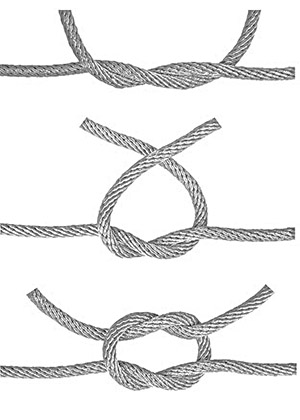 The reef knot is an old sailor’s knot. It was originally used to tie the reef points on a sail – cords that are used to tie part of a sail against the spars, to make it smaller in high winds. This task needs a knot that won’t slip, can be tied and untied in a hurry for fast adjustment of the sails, and that lies flat to avoid wearing holes in the canvas. The reef knot ticks all these boxes.
The reef knot is an old sailor’s knot. It was originally used to tie the reef points on a sail – cords that are used to tie part of a sail against the spars, to make it smaller in high winds. This task needs a knot that won’t slip, can be tied and untied in a hurry for fast adjustment of the sails, and that lies flat to avoid wearing holes in the canvas. The reef knot ticks all these boxes.
It’s also a very simple knot to tie.
Simply take the ends of the two ropes and cross them, left over right.
Now double them back on themselves and cross them right over left. Pull the whole thing tight. There you go; you have a reef knot.
A reef knot has several advantages. Although it holds securely, it’s also easy to untie. It’s relatively flat, so it doesn’t slide around as much as some other knots and also creates less wear on any surfaces in contact with it – which is important if you’re lashing a tarp over something you don’t want to get wet, because the reef knot won’t wear holes in it. If you’re using a rope as a belt, a reef knot will lie flat and minimize chafing.
Related: 30 Survival Items You Forgot to Buy
Essential Survival Knots #2: Figure 8 knot
Sometimes you need to tie a stopper knot in a rope or cord to make sure it doesn’t slip out of where it’s supposed to be. That could be the drawstring on your coat’s hood, or the downhaul on a pulley, but either way the principle is the same – if there’s a knot on the end, it will stop the cordage from escaping its task.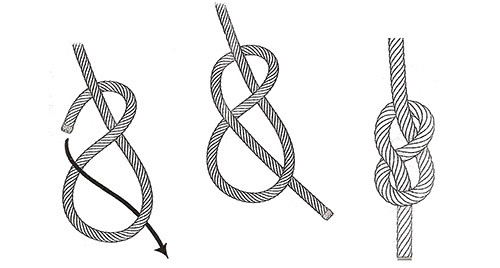
The simplest stopper knot, and the one everyone knows, is the pretzel-shaped overhand knot. Unfortunately it’s also a terrible knot, with a nasty habit of binding so tightly against itself under tension that it can never be untied. A much better alternative is the figure 8 knot.
To tie a figure 8 knot, lay the end of the rope over itself to make a loop. Pass the end around the rope, then back through the loop, and pull it tight. You’ll end up with a large and effective stopper knot that won’t bind to itself, so it can be undone. Just don’t tie it too close to the end of the rope – if you do that, occasionally it will undo itself.
Related: How to Assemble a Flawless Snare for Survival in Just 5 Minutes
Essential Survival Knots #3: Round turn and two half hitches
Ropes usually need to be attached to something, such as a branch, tie-down ring or bollard. A reliable way to do that is with a round turn and two half hitches. This is a strong knot that uses friction against both the support and the rope itself to resist slipping. It also has the advantage that the first part – the round turn – is very easy and quick to do, and will take a lot of the load while you finish it off. That makes it useful for tying up boats, or securing a load that’s already starting to shift. To tie the knot, get one end of the rope round whatever you want to tie it to, leaving yourself with a good length to work with. If there’s already a load on the rope that lets you snub it, helping to bring the load under control. Now pass the end round again, giving more friction and more control. If the load is very heavy you can add one or more additional turns.
To tie the knot, get one end of the rope round whatever you want to tie it to, leaving yourself with a good length to work with. If there’s already a load on the rope that lets you snub it, helping to bring the load under control. Now pass the end round again, giving more friction and more control. If the load is very heavy you can add one or more additional turns.
Next, wrap the end round the standing (loaded) part of the rope and pass it through the loop you create. Repeat the process, wrapping it round again and through the new loop. Then just pull the end tight and you’re done. The half hitches you formed by wrapping the end round the standing part will lock off the knot; if you have spare rope you can add more for extra security, but two is usually plenty.
Essential Survival Knots #4: Butterfly knot
Need a secure loop in a rope? There are many ways of doing this, but the butterfly knot is one of the best. Often used by climbers, it’s handy if you can get some slack in the rope and need a loop that won’t slip under a heavy load.
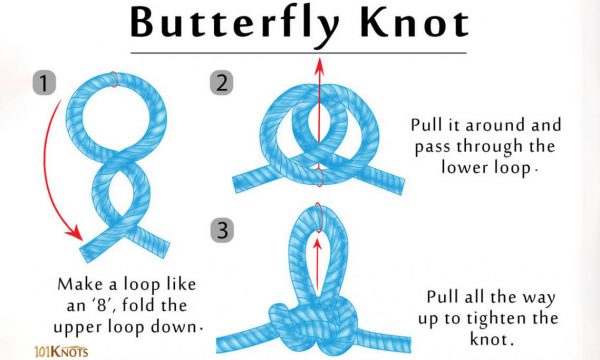
Gather in some slack and form an 8-shaped loop in the rope. Fold the upper loop down, pass it round the rope then thread it through the lower loop and pull it tight. That’s all it takes.
Are these all the knots you can use to help you survive? Nowhere near! There are hundreds of knots, some of them very specialized. The more you can learn, the better equipped you’ll be to survive. These four will cover most things, though. Get some bits of rope and practice until you can tie them confidently, and you’ll have a big advantage when modern fasteners aren’t available anymore.
You may also like:
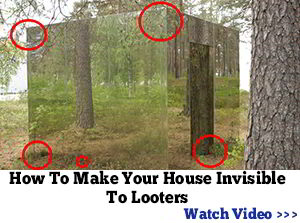 How To Make Survival Lamps With Used Cooking Oil and Mason Jars
How To Make Survival Lamps With Used Cooking Oil and Mason Jars
10 Things Cowboys Carried With Them in the Wild West to Survive (Video)
Did You Pass On These Skills To Your Sons When They Were Young?





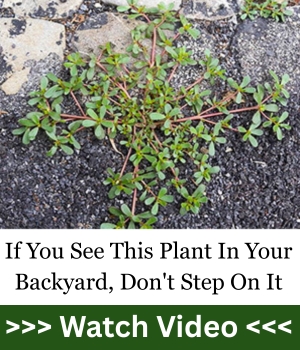
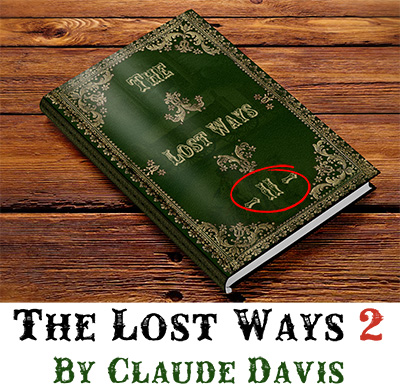
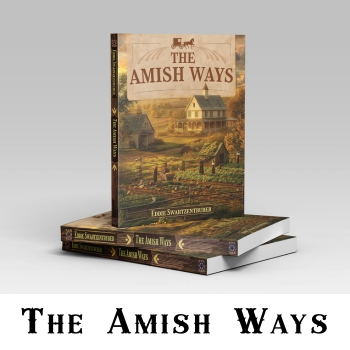

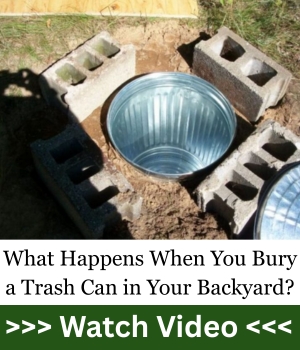






I suggest adding a bowline to your list, especially if you’re situated near water
Granted, I’m not a knot pro, but, I highly doubt I’ll ‘need’ more than the ones I already use easily, without having to stop and think about it – reef/square, figure 8 (which is another great option, in place of the butterfly, using the bight as an end, that then makes your loop), Larks head, slip knot, noose, half hitch, & bowline. That doesn’t mean I’m not open to learning more, and I’ve no doubt I’ll now pull out my ropes and play again, soon. Frankly, it kind of always cracks me up, to read these ‘the only ___ you’ll need’ and ‘you’re going to die, without ___’ kind of posts.
Grumpus,
Was the idea of “death”, w/o these knots mentioned? Your exaggeration is no better than what you claim these stories emphasize. You may not be grateful for the information but I’m sure it’s a learning experience for other people. Of course, now we all know how smart, witty and wise you are!
I think one should also learn the hangman’s noose. It should come in handy in the future after Nuremburg II.
I absolutely agree with Amy about the bowline. When I met my husband, who was a sailor, the first knot he taught me was the bowline. It is easy to learn, and easy to release.
You remember the rabbit ?
Up the hole, around the tree, and back down the hole. Or something like that.
the latest article on this site (as of the writing of this comment) does in fact feature the bowline
Having almost drowned when I was 5, I started practicing as a kid putting a line around myself and completing a bowline with one hand (in case one arm or hand was damaged). Yes I practiced with each hand. Haven’t needed it yet but I am on the water a lot and can still do it at 73.
First knor is a Square Knot.
yes … it is a square knot.
but that is a mountaineering term,
which came later.
the original name for it is reef knot.
Perhaps you can get by with 4 but the more knots you can tie without thinking the happier you’ll be. There are many more that sure come in handy..
No argument there. Any knot that holds will do in a pinch, but there’s a specialist knot for just about every task and if you know it, you’ll be able to get the job done better. Any time I find a new knot, I learn what it’s good for and how to tie it.
As far as I can tell you missed one of the most important and most used knots, the bowline knot
Reef Knot? Seriously? I am 62 and used rope all my life, and never ran into anyone wanting to show that they knew the very seldom used term “reef knot”. This is universally known as a square knot, and everyone knows it.
It is. Both. A Squae knot is when tht knot is secured, locked into place. But when one takes the tail section of one side of the knot, and the line side on the other end of the knot and pulls the ends away from eachother, the knot rolls over and becomes the Reef Knot, (two half-hitches on a single rope.)
While the knot is in the Reef configuration, the knot can be slid into position, tightening, (shortening), what ever load it is used to secure against, or lengthened to allow slack against the load.
To lock the Reef Knot again, reverting it back into a Square Knot, simply pull the oppisit ends of the rope like before, which rolls the knot back into it’s previous shape, locking the rope against the bearing load. . .
In short; Grab, yank, slide, yank, done!
In a side note, never forget about the Double Loop Knot (truckers hitch), Bowline, or the Clove Hitch. The Sliding Sheep Shank is very adaptal and useful one to be farmiluar with especially in a storm environment.
You do not show 2 half hitches, you show a square knot.
no … actually … the original name is reef knot.
and has been known as that for centuries.
square knot is a modern term used by mountaineers.
but it is not the original name.
It’s a reef knot. Its original purpose was fastening the reef points on a sail. Square knot is an alternative name for it in the USA (nowhere else), but reef knot is also widely used here.
no … actually … the original name is reef knot.
and has been known as that for centuries.
square knot is a modern term used by mountaineers.
but it is not the original name.
Why are my comments not published?
Patience.
Because women are only to be seen and not heard
now THAT’S FUNNY!! Clearly, you’re not running for political office!! LOL!!
They are. And apparently you are correct about the Reef knot being called a square knot, in the USA. But abroad and in the USA, it really is the Reef knot
You should link to another site showing the other knots one and learn and use. Yeah I know they are used infrequently but they are used so it might be worth while learning them
4 knots is a start, just a start. Tenderfoot boy Scouts need 8. Bowline, bowline on a bite, clove hitch, sheet bend, figure 8, overhand, timber hitch, taut line hitch, truckers hitch, plus square, sheer and tripod lashings
Cap cresap,
Since you mentioned lashing, one should also know how to use rope to frap the cross joints. This simple procedure makes joints tight and allow someone with an axe, some trees, and cordage to make all kinds of sturdy items, from chairs & tables, to watch towers. I don’t know if current Boy Scouts teach this; but, our troop once build an entire encampment, with a watch tower, a long table, and several chairs, all from deadfall and jute twine. Today I would no doubt use paracord instead of the twine.
I suppose anyone that knows their knots a favorites or most used knots. As a retired firefighter, rescue instructor I suggest 3 more knots that can be life savers. Prusik knot, water knot, figure 8 with a loop.
Jake d,
I had totally forgotten about the Prusik that I still use rather frequently. I’ve used a pair of them with foot loops for ascending a rope and we teach that knot in our hunter education classes for use with a harness for fall restraint when using tree stands. It is used frequently enough that when using it, it’s often used as a verb “to Prussik”.
For those of us who frequently do rope work, some of these are just tied without much thought as to their use or name.
The first knot should be try KNOT to be in a survival situation where you would need a knot. I am knot being critical ,nor and I am KNOT a robot.
Truth B Told,
While knots may be useful for survival situations, this is not a survival website; but, one for preparedness, and knowing some useful knots can just make life easier. Most people can instinctively tie their shoes without looking or thinking, and unless your life is just sitting around in front of the TV or computer, there will be times when knowing some knots will be useful for everyday non survival related tasks. If for instance, you want to haul some dimension lumber home from the store, how do you tie it down so it doesn’t slide off on the way home?
Bowline knot explained
https://www.youtube.com/watch?v=Q9NqGd7464U
As I think we can see from the comments, anything that starts “The only *blank* you’re ever going to use…” is quite a misnomer for a title, though it definitely sparks discussion. It appears that there’s a few more knots that you should know than just the 4 listed, and those may not be the best.
Checking on the Scouting BSA site, Tenderfoot knot requirements are:
Demonstrate a practical use of the square knot.
Demonstrate a practical use of two half-hitches.
Demonstrate a practical use of the taut-line hitch.
2nd Class is:
Demonstrate tying the sheet bend knot. Describe a situation in which you would use this knot.
Demonstrate tying the bowline knot. Describe a situation in which you would use this knot.
1st Class is:
Discuss when you should and should not use lashings.
Demonstrate tying the timber hitch and clove hitch.
Demonstrate tying the square, shear, and diagonal lashings by joining two or more poles or staves together
Use lashings to make a useful camp gadget or structure.
I would argue that these would make a better knowledge base for a survival situation. Granted, they would take more than a single article to cover fully.
All that being said, there’s nothing grossly wrong with this article, especially in the sense that it quickly brought about discussion on other knots that might be more useful.
Having worked on deep sea (meaning international) commecial vessels for almost 18 years I must disagree with the four choices. The “reef” knot, more commonly known as a square knot is a good one. But you neglected the Bowline and the clove hitch.
In my years working offshore I used these (bowline, clove hitch, and the square knot) almost everyday. I hardly ever used some of the “fancy knots” like the figure 8. I did use a “butterfly knot” more commonly known as a truckers hitch on occastion. Knowing how to do a quick bowline (or double bowline) could save your life one day.
Agreed. Bowline and square knot are two required knots. Personally, I use the tautline quite a bit when camping…much more than two-half-hitches, and actually use the slip knot a good bit as well. I guess those would be my 4 knots.
JKS, as a former member of the United States Coast Guard (deck ape) I absolutely concur with your assessment.
After a lifetime working outdoors on dry land I have mostly used the trucker’s hitch, half hitch, and running bowline. I am not a sailor but I will get salty with anybody who ties a knot I can’t loose with a tug or two. Also, for hauling firewood or cut brush I take a length of rope, double it and lay the load across the rope. Then I run the free ends through the other end and pull them back which cinches down on the load and secures it so you can carry it dragging or over your shoulder. Then you just pull the rope back out from your load. Don’t know if this qualifies as a knot or if it has a name, sure saves a lot of trouble.
Well Ivy Mike it is a form of slip knot but whatever someone names it I use it often enough. It’s a quick way to carry things. I gather up. Apple orchard trimmings from a neighbors place. Since I can’t drive in I often gather arms full and use this “knot” to carry them slung over a shoulder. I happen to like food cooked over fruit wood. The neighbor want the wood gone.
Good article. Created a good discussion.
Clove hitch, bowline and slip knots are absolutely necessary.
Sheep shank is one I have used all my life tying down loads. And yes it’s called a reef knot in places outside the US.
I did a lot of rock climbing and spelunking in my youth and found the most used knots were the Figure 8 and one you didn’t list, the bowline or bowline on a bight,
That allows one to make fixed-size non slip loops in the middle of a rope. An advantage is that it is reasonably easy to untie after tension on the rope has tightened the not. It can also be used to replace the figure-eight knot when tying into a climbing harness.
Another simple and easy one specifically for hoisting is a series of half hitches spread evenly along a pole for lifting. Keeping tension on the rope from both ends grips the pole and allows it to be hoisted up to someone who needs it; but, merely holding the pole and releasing the tension allows it to loosen, unwrap , and easily slip away from the load. I once used this to hoist a 6 foot 18 pound spud bar 40 feet up a quarry cliff
My go to place for learning or refreshing knots is: https://www.animatedknots.com/
Third article I have printed in two weeks. This is great info. I was able to acquire an old boy scout manual used back in the sixties and is chock full of this type of info. The manuals today are more focused on social justice unfortunately. Tried going through organization with my oldest son, it is NOT what it was when I was a kid and definitely not what it was when many of you older generations were kids. Back then they actually taught survival and life lessons now it is all about equality and don’t hurt each others feelings. I said all of that to encourage you to find older boy scout Manuel’s that have many of these knots and a ton of other survival skills. That way you have a hard copy and even a child can learn from them seeing that is who they target anyway. Filled with illustrations as well. A great resource to have on hand when SHTF, or just everyday life really.
Sounds like it may depend on the troop as the one my son joined this year does teach survival, knots, life lessons and the like, though yes they also teach anti-bullying, awareness of cyber-bullying, youth protection training and procedures for the adults (based on past failures in BSA which some churches like the Baptists are just now waking up to try to start controlling).
Wannabe. Agree on the old scouting manual. It’s a treasure. I found mine at an estate sale. Well worth the $1.
Our church group taught us much like scouts but in a mixed group of boys and girls. To earn my badge I had to make a 32 knot board. We were also encouraged to learn Camp Craft, Tracking, Blazing trails. Marking for others to follow or how to not leave a trail, Camp Cooking (on a flat rock, a stacked stone oven, a reflector oven made of cardboard and foil, in a can or hung pot et), Direction finding and telling time by a cast shadow once you found north. We had to prepare a board with the 16 common directions on it. We made teepees for a campout. We could use a tarp for shelters or a pup tent. Many things… I wish our youth were learning those things.
I made a teepee just big enough for four kids to crowd into it. Covered it in old sewing materials thrown on like a crude skin covering. It shed rain. The kids loved it. One son slept most of that summer in the teepee. It was set on a slight high point in the land. In spite of summer monsoons he stayed dry.
That’s the stuff our kids need and could enjoy. You never know when you might need some of it.
Mom took me Forraging for lambs quarter when I was four. We gathered enough for our dinner. My two older boys loved wildmustard flowers as a sandwich with cheese. They would come in with hands full so they could get cheese or cheese and bread to eat with the flowers.
Wild mustard is almost the state flower of the PDRK. It goes like a weed everywhere. I didn’t know the blossoms could be eaten. Another bit of survival information casually gained. Actually, it is considered a noxious pest here in the PDRK as it is not “natural.” Big emphasis on getting things back “as they used to be” without defining the time period. Of course the first thing we would have to do is get the state population back down to about a half a million. Tough one, that. Everyone who has ever tried significant population reduction has gotten extremely bad press. Hard to get volunteers too.
when I was in the Navy I used the bowline more than anything else. I can make it left or right handed in front or behind my back. worked with lines quite a bit. No one mentioned about a pig tail used to keep a mooring line from slipping. I would make tapered pig tails anchored to a cleat at each station. Hand lines 100ft with a Monky fist at the end (made my own) used to throw to shaw so the mooring lies could be pulled to the ship for docking.
In more than 20 years in the road transport industry, I used mostly just two knots and one of them isn’t actually a knot, namely the so-called truckers or truckies hitch, which is actually a sheepshank. So, I used that and a clove hitch and sometimes a half-hitch just to use up excess rope and for added security. However, I’m not going to discount the value of the bowline knot, mostly because its the only knot that I know that can be easily undone, no matter how much tension is placed on it. Some other knots may come in handy in special circumstances, but for the most part, the knots that will be used most are the sheepshank, the clove hitch and the bowline.
Boy Scout book have lots of good usable information. If you find one at a yard sale or an old books shop get it it more than pay for itself in a survival situation.
Caution. the reef knot is for lashing only. Do not use it for joining two ropes. For this use a figure 8 or a sheet bend. I second what everyone says about the bowline knot. Learned to tie one single handed around my waist whilst climbing.
Long running unanswered question about the bowline I’ve been pondering for years. Does it matter which way around the tree the rabbit goes? The end ends up either inside the loop or outside. It works either way.
In today’s world, hardly nobody wants to learn to tie knots. It is truly a lost art. In August of 1967, I had a farming accident. I was in the hospital for 34 days after I got my left arm caught in the auger of a feed grinder. After a few days went by, a little man walked in the room and asked if anyone wanted to learn to tie knots. I was a Boy Scout and I knew how to tie knots before the accident. This would be a challenge but I tied one knot after the accident and that was on the tourniquet I tied around my arm. I said I wanted to learn so he introduced himself as Kenneth Apolant. Mr. Apolant went to town teaching his best. After many attempts, I tied my first knot using my good hand and my teeth. I got even better when I could use my left hand index finger, too! lol Mr. Apolant came in to see me carrying a gift for me. It was a knot board that he made for me that had 30 knots tied and mounted on this board. It was awesome and I cherished it for years. Mr. Apolant worked for years with the Boy Scouts of America doing that exact same thing. He taught youngsters to tie knots. Today, nobody really knows how to tie the knots they need. These four knots the author is showing is more than most people today will ever know how to tie. I do agree that a bowline is needed, too, but these four types of knots will do for now. P.S. I am not totally sure of the spelling of Kenneth Apolant’s last name but, in 1967, at Children’s Hospital in Akron, Ohio, to me, he was a definite hope giver sent by God.
Looks to me that the middle illustration of the reef knot is incorrect. The first illustration shows left over right, but the second illustration also shows left over right. The third illustration is correct (right over left) but that could not have resulted from what’s showing in the second illustration.
I think some pictures to go along with the steps or at least of the completed knot would be very helpful for visual learners. I teach middle school and no matter your age a visual to go a long makes it way easier to grasp. I can also look elsewhere for them. Love all teh tips.
Just like most of these articles, this one gets everyone contributing! I usually get my best info from the comments plus many that are just plain negative! Thanks to The Ohio Prepper for the very useful and positive input!